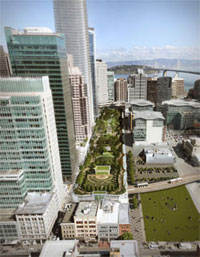San Francisco says it is closing in on the goals of its 2004
Climate Action Plan and released its strategy to meet the more stringent goals it set for 2025.
This "shows that it is possible to reduce the harmful emissions that cause climate change at a citywide scale," says the website, providing a model for other cities to follow.
San Francisco’s Department of Environment believes it can beat its goals of reducing GHG emissions 25% below 1990 levels by 2017, and 40% by 2025.
As of 2010, the City has cut greenhouse gas (GHG) emissions 14.5% below 1990 levels across the building,
energy, transportation and waste sectors, even as it has expanded its economy
(measured by gross domestic product) 40% and its population by 11%.
Indeed, electricity
demand went up 11% from 1990-2010, but GHG emissions from buildings still went down because of the
decreasing carbon intensity of the electric grid.
The city’s new downtown regional transit hub, which is under construction, will be topped
by a green roof that has bicycle and walking paths, a playground, café, a cultural center and a 1000-person amphitheater:

Part of the reason for this progress is that San Francisco took on the challenge of addressing climate change early, back in 1996, when it released its first Sustainability Plan. By 2002, the state of California had its Renewable Energy Portfolio Standard, and the city was among the first to require its 60-plus city agencies to develop and track Departmental Climate Action Plans. Agencies track vehicle and building energy use, water use, waste disposal and purchasing.
Also in 2002, San Francisco set the goal of achieving zero waste by 2020, with an intermediate goal of 70% by 2010. As part of its commitment to the US Conference of Mayors, it developed the 2004 Climate Action Plan. Also, two dirty power plants have been closed.
San Francisco’s newly revised Climate Action Strategy is based on three objectives:
- Achieve zero
waste by 2020 through recycling and composting and reduce the total amount of waste generated through materials management and producer responsibility policies.
San Francisco leads the country – keeping 80% of waste out of landfills through source reduction (such as its plastic bag ban), reuse, recycling and composting. Now, recycling and composting is mandated for households and businesses."Strong political leadership, progressive waste reduction policies, and extensive education and outreach to residents and businesses have been critical to our success," says David Assmann, Interim Director of the San Francisco Department of the Environment.
-
Shift 50%
of all trips to non-automobile
transportation by 2017; and 80%, by 2030.In addition to expanding public transportation
infrastructure, including ridesharing and biking, the plan is for its railroad BART to run on 100% renewable energy, and for its taxi and bus fleet to convert to renewable fuels."San Francisco has one of the cleanest municipal fleets in the nation," says Ed Reiskin, San Francisco’s Director of Transportation. "More than 50% of the city’s transit
system is zero emission electric vehicles. With additional investments in our public transit system, our bike lane infrastructure and pedestrian safety, San Franciscans will have even more clean, viable, safe and effective
transportation options." - Source 100% of residential and 80% of commercial electricity from
renewable sources and reduce consumption 2.5% a year. The city, which ranks #4 in the country on energy efficiency, mandates that all commercial buildings benchmark and track energy use and large buildings meet LEED-Gold standards. It recently exceeded the milestone of 4000 solar installations.All government buildings now run on 100% renewable electricity and buses use B20. New goals will transition the government to 100% carbon-free fuel for its diesel fleets and transition off inefficient gasoline vehicles.
"San Francisco’s GoSolarSF incentive program is making the process of going solar easier and more affordable," says Josh Arce, President of the Environment Commission.
It has accelerated growth of the local solar industry, creating thousands of jobs.
The city also plans to expand forest cover to 25% of its land area.
And it is one of 10 cities to announce it is divesting from all fossil fuel investments. Another great initiative is CleantechSF, which is supporting growth of the cleantech industry.
San Francisco is part of the growing coalition of cities worldwide that are fighting climate change on the local level in the absence of federal action. Known as the C40 Cities Climate Leadership Group, the largest 40 cities in the world are members.
Read San Francisco’s Climate Action Strategy:
